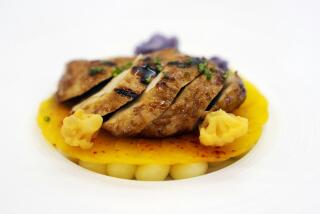Some Italian salumi youâve never tasted may be available soon
Fans of Italian cured meat products such as culatello, pancetta and salami are already smacking their lips. And so are the folks who make the wonderful salumi, so many of which have been unavailable in the United States -- until now.
On Friday, the Department of Agriculture quietly published a determination in the Federal Register that six Italian regions are now clear of an obscure malady of pigs called swine vesicular disease.
Though that hardly sounds earthshaking, it effectively clears the way for importation into the United States of a wide range of Italian meat and cured meat products, starting May 28.
The Italian association of meat producers (ASSICA) issued a news release calling the change âhistoricâ and âa momentous event.â
The affected areas include some of the most salumi-crazy areas of northern Italy: Lombardy, Emilia-Romagna, Venice, Piedmont, Trento and Bolzano.
Although a few Italian pork products have been imported into the U.S., including prosciutto from Parma and San Daniele and mortadella, many more have been excluded because of the fear of swine vesicular disease -- a malady first detected in the mid-1960s that can survive cooking and even long curing.
The disease is still found in parts of central and southern Italy, but the north has been clear. So, provided the packinghouses and factories have been approved by the USDA, their products can be exported to the U.S.
Among the most sought-after products benefiting from the ban will be culatello, a cult item from the Parma region of Emilia-Romagna that is made by curing the âheartâ of a ham. It is extremely expensive, even in Italy.
But not all imports will be so rarefied. Indeed, perhaps the biggest beneficiary could be the wide range of cured sausages generically referred to as salami. There are hundreds of varieties of these; seemingly every town has at least one it calls its own.
Though itâs unlikely the smallest producers will be able to qualify for export, many of the better-known types, such as salame di Felino, made in a small town in the Parma area, will.
And some products will be available only from certain areas. Lardo, for instance, back fat cured with rosemary and spices, can be imported legally when itâs made in one of the approved regions, but not from its most famous producers in Colonnata, which is in the still-restricted area of Tuscany.
And thereâs a difference between being able to import the meat legally and being able to sell it profitably. Over the last decade there has been a burgeoning artisanal cured meat culture in the United States, selling products similar to the Italian and sometimes even under the same names.
But for lovers of cured meats, thereâs little doubt that when it comes to salumi, the more the merrier.
ALSO:
Ben Affleck eats on $1.50 a day?
Selling Italian dressing by undressing
More to Read
Eat your way across L.A.
Get our weekly Tasting Notes newsletter for reviews, news and more.
You may occasionally receive promotional content from the Los Angeles Times.











